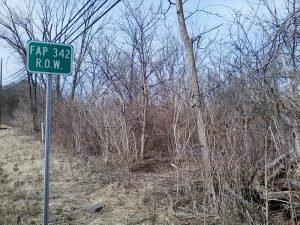Route 53 environmental study receives tollway funding
Gregory Harutunian for Chronicle Media — December 27, 2016
The road sign (F.A.P. 342) along Route 22 in Long Grove marks the crossover for the Route 53 extension through Lake County. (Photo by Gregory Harutunian/for Chronicle Media)
An environmental impact study to be completed in advance of full design and engineering plans on the proposed Route 53 extension into Lake County was given a $10 million allotment, as part of the Illinois Tollway Authority Board’s fiscal year budget, during its Dec. 15 meeting. Although Lake County officials indicate their position to move forward on the project has not changed, some support has eroded.
The environmental impact study was recommended by a 2012 Blue Ribbon Advisory Council (BRAC) comprised of Lake County board members, village administrators and mayors in the county, and other legislative officials, which also approved the extension as a basis for an economic boon to the area. The study’s allocations were tabbed at $40 million to $50 million over a four- to five-year period.

The proposed route 53 extension through Lake County will run from Lake-Cook Road in Buffalo Grove to Route 120 in Lakemoor. (Photo by Gregory Harutunian/for Chronicle Media)
“The Tollway’s 2017 Budget includes $17.3 million for emerging projects and planning studies that include new technology initiatives, our tree planting program, additional commercial truck parking opportunities along the Tri-State Tollway, (along with) potential ramp and interchange improvements on our system,” said Dan Rozek, the tollway authority spokesperson, in an emailed response.
“A portion of the Environmental Impact Statement (was designated) for the Illinois Route 53/120 Project,” he said. “There has been no decision made at this point to move forward with an environmental impact study for the Illinois Route 53/120 Project.”
The tollway authority had made overtures last summer regarding a search for consultancy firms to conduct the study, however Rozek indicated that no selection was forwarded.
The Illinois Tollway Authority passed a resolution in December 2015 to authorize a nearly $45 million environmental impact study (EIS), with a $6 million opening annual outlay and a timeline for the report to be finished in 2020. The EIS would determine the corridor’s viability of extending Route 53 through Lake County, from its southern terminus at Lake-Cook Road, north to Route 120.
Support in the county was diminished, when Lake County Board chairman Aaron Lawlor withdrew his support for the project, in lieu of a “high quality” sustainable environmental program to protect natural resources and include a trail through the corridor. At a May 17 press conference, held at Grayslake’s Prairie Crossing, he cited a perceived inability to fund the estimated $2.65 billion project, acquiring the remaining right-of-way properties, best use of the corridor considerations, and the financial gridlock in the Springfield state legislature.
In a released statement, Lawlor said, in part, “As a result, I believe the best thing for Lake County would be to stop the Environmental Impact Statement and refocus our attention on a sustainable vision for the current Route 53/120 corridor and plan for necessary improvements to our county’s current transportation network.”
Lake County Administrator Barry Burton maintained there has been no sea change.
“There is no discussion on the Route 53 project at the county board level,” he said. “The Blue Ribbon Panel delivered its report and we’re waiting on their decision at the tollway authority. Ultimately, it’s a tollway project.
“There’s been no conversation with the tollway authority, no consultant firm hired, as far as I understand, this is a tollway project, with $50 million for the study, and they worked on the process last summer. Board chairman (Aaron) Lawlor expressed his opinion.”
Issues brought out at the tollway board’s budget meeting included the prospect of lacking funding mechanisms to actually finance the project’s construction and ancillary costs. The BRAC report indicated the cost for using the 25-mile roadway would be 20 cents per mile, with additional charges during rush hour periods listed as “congestion pricing.”
According to a flier, available at the Lake County courthouse and other locations, a special taxing district would also be instituted “to capture 25 per cent of the real estate value for adjacent new non-residential development that would be dedicated to the Environmental Restoration and Stewardship Fund.”
Proposed in the early 1960s, the intended path carries a federal right-of-way designation marked by signage through farm fields in the Lake Zurich-Hawthorn Woods region, north to the Volo-Lakemoor area. The state has acquired nearly two-thirds of the properties necessary for the corridor, and Lake County government officials saw the project as a model of the future, and an economic engine along with providing an alternative to existing congestion problems.



